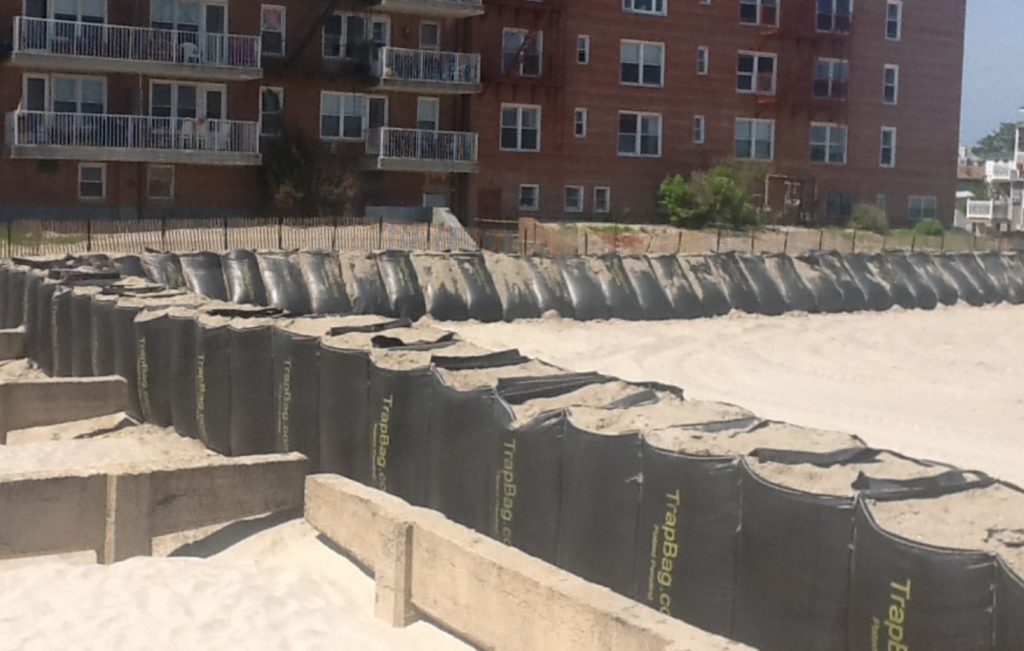How TrapBags Provide Hurricane Protection
Hurricane flooding can demolish communities, leading to death and the destruction of vital infrastructure. Hurricane flood barriers protect people and property.

Hurricane Damage Is Preventable
Hurricanes can be extremely dangerous, destructive storms that lead to costly repercussions for coastal and inland municipalities alike. While hurricanes themselves are not preventable, the level of damage they can inflict on a community can be mitigated through effective hurricane protection like TrapBag barriers.
What Causes the Most Damage During a Hurricane?
While the high winds that accompany hurricanes are damaging, hurricane flooding is the most serious threat, requiring thorough preparation pre-storm. Floods that result from hurricane rain and storm surges can claim lives, weaken public infrastructure, demolish commercial properties and residential buildings, and destroy previously thriving ecosystems.
The ramifications of hurricane-related damages are far reaching. Places that rely on tourism as an economic venture, like the Caribbean, can be devastated for months to years after a hurricane. Hurricane damage repair is especially difficult on islands, where removing debris and rebuilding infrastructure is at the mercy of vessels transporting materials.
Daily life, as well as the health and safety of local communities, can be further disrupted when hurricane flooding impacts necessary forms of public infrastructure, like bridges, roads, schools, and water treatment plants. Protection of these vital structures is integral to lessening expensive damages and the subsequent tedious rebuilding it takes to return hurricane-affected areas to normal life.
What Is a Hurricane Barrier?
Hurricane barriers protect municipalities from flooding during and after hurricanes. Barriers can take many forms, depending on what type of infrastructure needs protection. Investing in effective hurricane protection barriers that prevent significant, costly, and life-interrupting damages is the responsibility of local municipalities.
Who Needs Hurricane Flood Barriers?
Any area that experiences annual hurricane or tropical storm action needs to be supplied with hurricane protection barriers before hurricanes begin—as they can be difficult to predict, residents do not always receive ample warning. Climate change is exacerbating the severity of hurricanes as a result of unparalleled rainfall, rising sea levels, and warming water temperatures.
The National Oceanic and Atmospheric Administration’s hurricane records began in 1851. U.S. states that are most vulnerable to hurricane damage include:
- Florida: Since 1851, Florida has been hit with over 120 hurricanes, 35 of which were considered to be major hurricanes.
- Texas: Since 1851, Texas has seen 66 hurricanes.
- Louisiana: Since 1851, Louisiana has seen 54 hurricanes, and is the only state in the U.S. to have been hit by two storms over 150MPH.
- North Carolina: Since 1851, North Carolina has seen 55 hurricanes.
- South Carolina: Since 1851, South Carolina has seen 30 hurricanes.
Outside of the U.S., hurricanes (referred to as typhoons) most often happen in countries in Asia, Central America, and Oceania, including:
- China: Typhoons occur an average of 17 times a year in China.
- Philippines: Typhoons occur an average of 16 times a year in the Philippines.
- Japan: From 2012–2021, 35 typhoons landed in Japan.
- Mexico: Typhoons occur an average of 17 times a year in Mexico.
- Australia: Typhoons occur an average of 13 times a year in Australia.
Types of Hurricane Flooding Protection
There is an assortment of temporary and permanent hurricane flood barriers on the market, with varying levels of effectiveness.
Sandbag Flood Barriers
Many people may think of traditional sandbags when hurricane protection is discussed. However, these barriers aren’t as successful as you may think. Sand bags are individual cells that must be stacked together in a tight enough formation that water cannot penetrate the wall. This can be difficult to achieve, especially if deployment is rushed. Many sandbags are required to form a protective barrier. One 100-foot section of 4-foot high TrapBags replaces approximately 8,000 sandbags!
Water-Activated Flood Barriers
Flood barriers of this nature are ideal for very small-scale scenarios, but are not suitable for hurricane floods.
Water-activated flood barriers absorb water, holding a finite amount. Once the limit is reached, if floodwater levels exceed the height of the barrier, the water-activated flood barriers are rendered ineffective.
Another downside to water absorbing barriers? It is extremely important to pre-activate them, as they do not begin working until touched by water. This can be too dangerous to attempt during a hurricane.
Concrete Flood Barriers
A permanent type of flood barrier, concrete barriers may be constructed near the coast as a sort of seawall, deflecting large waves before they can reach land. While these can be successful, they must already be in place and cured prior to a storm approaching. When situated on an already weakened foundation, like that of a wave-battered coast, heavy concrete barriers can worsen erosion and become less effective over time, requiring repairs.
Inflatable Flood Barriers
Inflatable flood barriers are another form of temporary flood protection. These barriers are pre-filled with water, and while they are durable against debris, they require a large water source to fill, are not able to be stacked to ward off rising water levels, and are less effective on permeable ground.
Hurricane Protection Is Possible with TrapBag
TrapBag barriers are the superior option for temporary or permanent hurricane flood barriers, both during a hurricane and afterwards in the rebuilding process.
TrapBag Levees
Levees protect low-lying land from rising river levels. During hurricanes, significant, atypical water levels are inevitable. Temporary levees can be constructed from TrapBag barriers to protect commercial properties, residential areas, or agricultural plots. TrapBags can also be added onto an existing levee, preventing breaches, extending its length or height, protecting against increasing water levels.
TrapBag Dams
Dams are extremely important to have in place during a hurricane. TrapBags can be easily stacked to create stable, leak-resistant dams that mitigate flood damage. TrapBags are also an effective solution for those seeking to provide additional stabilization to existing dams, which can be the difference between a dam standing strong or catastrophically failing.
TrapBag Diversion Barriers
Diversion barriers work to change the pathway a flood is taking. Durable diversion barriers made of TrapBags can direct water to a safer destination, protecting the people and property of a hurricane-riddled community. Diversion barriers are also ideal for blocking debris that enters the roadway during hurricane flooding, which can be dangerous for civilians, make rescue operations more difficult, and damage infrastructure.
TrapBag Stormwater Containment
Stormwater runoff is the result of large amounts of rain leading to flooding. If this flood water becomes contaminated and enters waterways, or is reabsorbed into the ground, it can be devastating to the ecosystem. Stormwater containment basins made of TrapBags are a long-lasting solution to this harmful runoff.
Benefits of TrapBag Barriers
TrapBag barriers are the most effective, reliable form of protection to utilize when a hurricane is approaching, as they are:
-
- Durable: TrapBags are made of a high-strength geotextile material that prevents debris from puncturing the barrier. Once deployed, TrapBags have a lifespan of five years, providing your community with long-term protection.
- Dependable: TrapBags’ unique engineering is illustrated by their interconnected, accordion-like structure. This design prevents water from leaking through, an extremely important characteristic of effective flood protection.
- Rapidly deployable: The accordion-like design of TrapBags makes the deployment process simple and quick, a necessity when a hurricane is approaching. Unlike other forms of flood protection that require individual cells to be carried and placed, TrapBags are easily pulled apart and filled once in place.
- Versatile: TrapBag barriers can create many forms of flood protection, suiting whatever your environment requires—dams, levees, diversion walls, seawalls, infrastructure support, and stormwater containment ponds. TrapBags are also versatile in the kinds of barriers they can construct—when filled with sand or washed gravel, they are ideal for temporary flood protection. When filled with concrete, they can be permanent structures designed to divert flood waters.
- Easy to install: While some forms of hurricane flood protection require heavy machinery to install, TrapBag barriers do not. This ease of installation is necessary in combating flooding, which can occur quickly once a hurricane hits.
- Efficient: TrapBags require less fill than traditional methods of flood protection. In fact, TrapBags require 40% less fill than traditional sandbags, saving you money in the protection process.
Reliable Hurricane Protection
Hurricanes will continue to occur, but the damage they have on your community can be mitigated with the installation of TrapBag barriers. Send us a message today to learn about how you can get TrapBags delivered to you—we ship worldwide.
Meet the author
Get the Dirt Before the Flood Hits
Stay ahead of flooding, erosion, and disaster response challenges. The Dirt, TrapBag’s monthly newsletter, delivers field-tested tips, real-world case studies, and the latest in barrier technology straight to your inbox.

